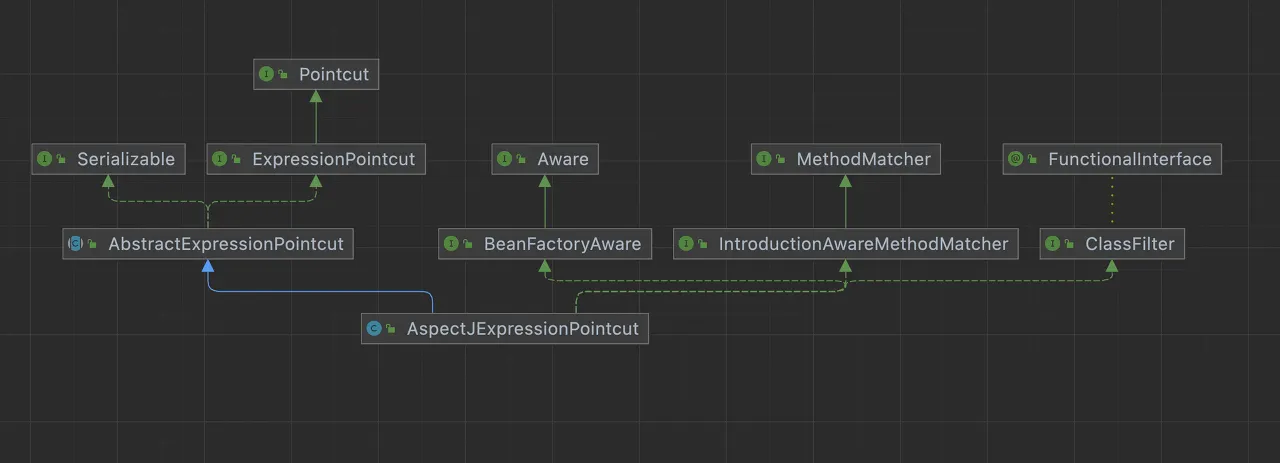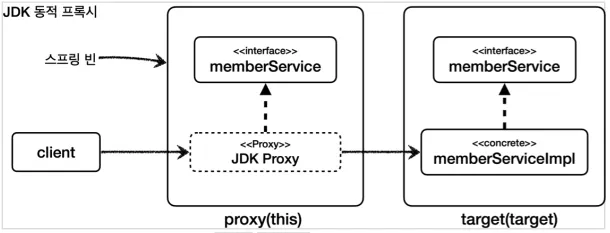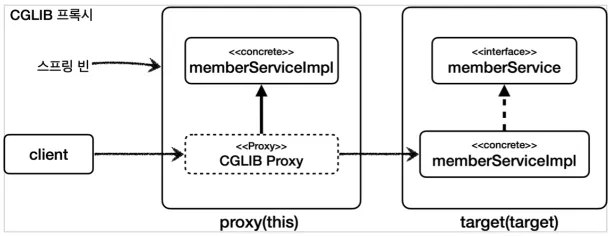참고
포인트컷 지시자 종류
NOTE
포인트컷 표현식은 execution같은 포인트컷 지시자(Pointcut Designator) 줄여서 PCD라고 한다.
AspectJExpressionPointcut은 포인트컷 표현식을 처리해주는 클래스! (자세히 보면 위에 Pointcut을 받음)
•
execution (사실 이것만 알아도 됨!) 
◦
메소드 실행 조인 포인트를 매칭한다.
◦
스프링 AOP에서 가장 많이 사용하고, 기능도 복잡하다.
•
within
◦
exectuion에서 타입 부분만 사용한다고 보면된다.
•
args
◦
인자가 주어진 타입의 인스턴스인 조인 포인트로 매칭한다.
•
this
◦
스프링 빈 객체(스프링 AOP 프록시)를 대상으로 하는 조인 포인트
•
target
◦
Target 객체(스프링 AOP 프록시가 가르키는 실제 대상)을 대상으로하는 조인 포인트
•
@target
◦
실행 객체의 클래스에 주어진 타입의 애노테이션이 있는 조인 포인트
•
@within
◦
주어진 애노테이션이 있는 타입 내 조인 포인트
•
@annotaion
◦
메서드가 주어진 애노테이션을 가지고 있는 조인포인트를 매칭
•
@args
◦
전달된 실제 인수의 런타임 타입이 주어진 타입의 애노테이션을 갖는 조인 포인트
•
bean
◦
스프링 전용 포인트컷 지시자
◦
빈의 이름으로 포인트컷을 지정한다.
•
여러 지시자중, execution을 가장 많이 사용하고, 나머지는 잘 사용하지 않으니 execution을 중점적으로 학습하자!
AspectJ Pointcut 표현식
NOTE
AspectJExpressionPointcut을 사용하면, 정밀한 Pointcut을 설정할 수 있습니다.
// A만 적용됩니다.
@Bean
public Advisor timeAdvisor(TimeAdvice timeAdvice) {
AspectJExpressionPointcut aspectJPointcut = new AspectJExpressionPointcut();
aspectJPointcut.setExpression("within(com.example.study.aop.AutoProxyConfig.A)");
return new DefaultPointcutAdvisor(aspectJPointcut, timeAdvice);
}
// A,B 둘다 적용됩니다.
@Bean
public Advisor timeAdvisor2(TimeAdvice timeAdvice) {
AspectJExpressionPointcut aspectJPointcut = new AspectJExpressionPointcut();
aspectJPointcut.setExpression("execution(* com.example.study.aop.AutoProxyConfig..*(..))");
return new DefaultPointcutAdvisor(aspectJPointcut, timeAdvice);
}
// A,B 둘다 적용되지 않습니다.
@Bean
public Advisor timeAdvisor3(TimeAdvice timeAdvice) {
AspectJExpressionPointcut aspectJPointcut = new AspectJExpressionPointcut();
aspectJPointcut.setExpression("execution(* hello.proxy.app.test..*(..))");
return new DefaultPointcutAdvisor(aspectJPointcut, timeAdvice);
}
Java
복사
AspectJ Pointcut 표현식
•
execution: 메서드 실행(join point)에 대한 매칭을 정의한다.
◦
modifiers-pattern: 메서드의 접근 제어자(public, private 등)
◦
ret-type-pattern: 메서드의 반환 타입
◦
declaring-type-pattern: 메서드를 선언한 타입(클래스)
◦
name-pattern: 메서드 이름 패턴
◦
param-pattern: 메서드의 파라미터 패턴
◦
throws-pattern: 메서드가 던질 수 있는 예외
•
within: 특정 타입에 대한 매칭을 정의한다.
execution 
NOTE
execution(접근제어자? 반환타입 선언타입?메서드이름(파라미터) 예외?)
Java
복사
가장 기본적인 형태!
•
메소드 실행 조인 포인트를 매칭한다.
•
?는 생략할 수 있다.
•
*같은 패턴을 지정할 수 있다.
// 가장 정확하게 매칭하는 방법
@Test
void exactMatch() {
pointcut.setExpression("execution(public String hello.aop.member.MemberServiceImpl.hello(String))");
Assertions.assertThat(pointcut.matches(helloMethod, MemberServiceImpl.class)).isTrue();
}
// 가장 생략한 방법
@Test
void allMatch() {
pointcut.setExpression("execution(* *(..))");
Assertions.assertThat(pointcut.matches(helloMethod, MemberServiceImpl.class)).isTrue();
}
Java
복사
위의 경우는 1개의 메소드만, 아래의 경우는 모든 메소드가 검색된다.
•
매칭 조건
◦
접근 제어자? : public
◦
반환타입 : String
◦
선언타입?: hello.aop.member.MemberServiceImpl
◦
메서드: hello
◦
파라미터: (String)
◦
예외?: 생략
// 메서드 이름패턴으로 조회
@Test
void nameMatchStar1() {
pointcut.setExpression("execution(* hel*(..))");
Assertions.assertThat(pointcut.matches(helloMethod, MemberServiceImpl.class)).isTrue();
}
// 메서드 이름패턴으로 조회
@Test
void nameMatchStar2() {
pointcut.setExpression("execution(* *el*(..))");
Assertions.assertThat(pointcut.matches(helloMethod, MemberServiceImpl.class)).isTrue();
}
Java
복사
메서드 이름의 경우 *를 사용해서 패턴으로 조회가 가능하다.
// 패키지 이름패턴으로 조회
@Test
void packageExactMatch2() {
pointcut.setExpression("execution(* hello.aop.member.*.*(..))");
Assertions.assertThat(pointcut.matches(helloMethod, MemberServiceImpl.class)).isTrue();
}
// 패키지 이름패턴으로 조회
@Test
void packageExactSubPackage2() {
pointcut.setExpression("execution(* hello.aop..*.*(..))");
Assertions.assertThat(pointcut.matches(helloMethod, MemberServiceImpl.class)).isTrue();
}
Java
복사
패키지의 경우는 .과 ..을 통해서 조회가 가능하다.
•
. : 정확하게 해당 위치의 패키지
•
.. : 해당 위치의 패키지와 그 하위 패키지도 포함한다.
// 타입 조회
@Test
void typeExactMatch() {
pointcut.setExpression("execution(* hello.aop.member.MemberServiceImpl.*(..))");
Assertions.assertThat(pointcut.matches(helloMethod, MemberServiceImpl.class)).isTrue();
}
// 부모타입 조회
@Test
void typeExactMatchSuperType() {
pointcut.setExpression("execution(* hello.aop.member.MemberService.*(..))");
Assertions.assertThat(pointcut.matches(helloMethod, MemberServiceImpl.class)).isTrue();
}
Java
복사
execution의 경우 클래스의 부모타입도 검색이 가능하다!
// String 타입의 파라미터 허용
// (String)
@Test
void argsMatch() {
pointcut.setExpression("execution(* *(String))");
Assertions.assertThat(pointcut.matches(helloMethod, MemberServiceImpl.class)).isTrue();
}
// 파라미터가 없는 경우
// ()
@Test
void argsMatchNoArgs() {
pointcut.setExpression("execution(* *())");
Assertions.assertThat(pointcut.matches(helloMethod, MemberServiceImpl.class)).isFalse();
}
// 정확하게 하나의 파라미터 허용, 모든 타입 허용
// (XXX)
@Test
void argsMatchStar() {
pointcut.setExpression("execution(* *(*))");
Assertions.assertThat(pointcut.matches(helloMethod, MemberServiceImpl.class)).isTrue();
}
// 모든 파라미터 타입과 개수 허용
// (), (XXX), (XXX, XXX)
@Test
void argsMatchAll() {
pointcut.setExpression("execution(* *(..))");
Assertions.assertThat(pointcut.matches(helloMethod, MemberServiceImpl.class)).isTrue();
}
Java
복사
파라미터를 사용하는 경우
within
NOTE
execution에서 타입 부분만 사용한다. (별로 안씀)
@Test
void withinExact() {
pointcut.setExpression("within(hello.aop.member.MemberServiceImpl)");
Assertions.assertThat(pointcut.matches(helloMethod, MemberServiceImpl.class)).isTrue();
}
// 클래스 패턴매칭
@Test
void withinStar() {
pointcut.setExpression("within(hello.aop.member.*Service*");
Assertions.assertThat(pointcut.matches(helloMethod, MemberServiceImpl.class)).isTrue();
}
Java
복사
그냥 참고만 하자 (잘안씀)
args
NOTE
execution에서 인자값만 사용한다. (별로 안씀)
// exection -> 메서드의 시그니처로 판단 (정적)
// args -> 런타임에 전달된 인수로 판단 (동적)
@Test
void argsVsExecution(){
// Args
Assertions.assertThat(pointcut("args(String)")
.matches(helloMethod, MemberServiceImpl.class)).isTrue();
Assertions.assertThat(pointcut("args(java.io.Serializable)") // Serializable은 String의 부모타입중 하나
.matches(helloMethod, MemberServiceImpl.class)).isTrue();
Assertions.assertThat(pointcut("args(Object)")
.matches(helloMethod, MemberServiceImpl.class)).isTrue();
// Execution
Assertions.assertThat(pointcut("execution(* *(String))")
.matches(helloMethod, MemberServiceImpl.class)).isTrue();
Assertions.assertThat(pointcut("execution(* *(java.io.Serializable))")
.matches(helloMethod, MemberServiceImpl.class)).isFalse();
Assertions.assertThat(pointcut("execution(* *(Object))")
.matches(helloMethod, MemberServiceImpl.class)).isFalse();
}
Java
복사
String의 상위 타입인 Object의 경우 Args는 검색이되지만, Execution는 검색이 안된다.
@target, @within
NOTE
특정 조건의 애노테이션이 있는지 확인한다!
@target → 인스턴스의 모든 메서드를 조인 포인트로 적용
@within → 해당 타입 내의 메서드만 조인 포인트로 사용
@Around("execution(* hello.aop..*(..)) && @target(hello.aop.member.annotation.ClassAop)")
public Object atTarget(ProceedingJoinPoint joinPoint) throws Throwable {
log.info("[@target] {}", joinPoint.getSignature());
return joinPoint.proceed();
}
//@within: 선택된 클래스 내부에 있는 메서드만 조인 포인트로 선정, 부모 타입의 메서드는적용되지 않음
@Around("execution(* hello.aop..*(..)) && @within(hello.aop.member.annotation.ClassAop)")
public Object atWithin(ProceedingJoinPoint joinPoint) throws Throwable {
log.info("[@within] {}", joinPoint.getSignature());
return joinPoint.proceed();
}
Java
복사
target은 상위 타입까지 log가 나오지만, within은 안나옴
•
execution을 사용하는 이유는 @target의 경우 실행 시점에 일어나는 포인트컷 적용 여부도 결국 프록시가 있어야 실행 시점에 판단할 수 있다.
•
프록시를 생성하는 시점은 스프링 컨테이너가 만들어지는 애플리케이션 로딩 시점에 적용할 수 있으며, @target과 같은 포인트컷 지시자가 있으면 스프링은 모든 스프링 빈에 AOP를 적용하려고 시도한다.
•
내부에서 사용하는 빈 중에는 final로 지정된 빈들도 있기 때문에 오류가 생길 수 있어, 프록시 적용 대상을 축소하는 표현식을 사용한다.
@annotation, @args
NOTE
메서드가 주어진 애노테이션을 가지고 매칭한다.
@Override
@MethodAop("test value")
public String hello(String param) {
return "ok";
}
Java
복사
메소드에 애노테이션 적용
@Aspect
static class AtAnnotationAspect{
@Around("@annotation(hello.aop.member.annotation.MethodAop)")
public Object doAtAnnotation(ProceedingJoinPoint joinPoint) throws Throwable {
log.info("[@annotation] {}", joinPoint.getSignature());
return joinPoint.proceed();
}
}
Java
복사
애노테이션이 적용된 메소드에 AOP를 적용한다.
@args(test.Check)
Java
복사
@Check가 있는지 확인
•
@args는 파라미터에 애노테이션이 있으면 검색하는 용도
bean
NOTE
스프링 빈 이름으로 포인트컷을 매칭한다!
@Aspect
static class BeanAspect {
@Around("bean(orderSerivce) || bean(*Repository)")
public Object doLog(ProceedingJoinPoint joinPoint) throws Throwable {
log.info("[bean] {}", joinPoint.getSignature());
return joinPoint.proceed();
}
}
Java
복사
스프링 빈 이름으로 포인트컷 적용
매개변수 전달
NOTE
위에서 사용한 개념들을 스프링의 Advice에 매개변수로 사용할 수 있다!
@Pointcut("execution(* hello.aop.member..*.*(..))")
private void allMember() {
}
@Around("allMember()")
public Object logArgs1(ProceedingJoinPoint joinPoint) throws Throwable {
Object arg1 = joinPoint.getArgs()[0];
log.info("[logArgs1]{}, arg={}", joinPoint.getSignature(), arg1);
return joinPoint.proceed();
}
@Around("allMember() && args(arg, ..)")
public Object logArgs2(ProceedingJoinPoint joinPoint, Object arg) throws Throwable {
log.info("[logArgs2]{}, arg={}", joinPoint.getSignature(), arg);
return joinPoint.proceed();
}
@Before("allMember() && args(arg, ..)")
public void logArgs3(String arg) {
log.info("[logArgs3]{}, arg={}", arg);
}
@Before("allMember() && this(obj)")
public void thisArgs(JoinPoint joinPoint, MemberService obj){
log.info("[this]{}, obj={}", joinPoint.getThis(), obj.getClass());
}
@Before("allMember() && target(obj)")
public void targetArgs(JoinPoint joinPoint, MemberService obj){
log.info("[target]{}, obj={}", joinPoint.getThis(), obj.getClass());
}
@Before("allMember() && @target(annotation)")
public void atTarget(JoinPoint joinPoint, ClassAop annotation){
log.info("[@target]{}, obj={}", joinPoint.getSignature(), annotation);
}
@Before("allMember() && @within(annotation)")
public void atWithin(JoinPoint joinPoint, ClassAop annotation){
log.info("[@within]{}, obj={}", joinPoint.getSignature(), annotation);
}
@Before("allMember() && @annotation(annotation)")
public void atWithin(JoinPoint joinPoint, MethodAop annotation){
log.info("[@annotation]{}, annotationValue={}", joinPoint.getSignature(), annotation.value());
}
Java
복사
단독으로 잘 사용하지 않고, 이렇게 매개변수로 자주사용한다.
this, target
NOTE
JDK 동적 프록시 → proxy(this)의 impl을 찾을 수 없음
CGLIB → proxy(this)의 impl을 찾을 수 있음!
•
this
◦
스프링 빈 객체(스프링 AOP 프록시)를 대상으로 하는 조인 포인트
•
target
◦
target 객체(스프링 AOP 프록시가 가르키는 실제 대상)을 대상으로 하는 조인 포인트





